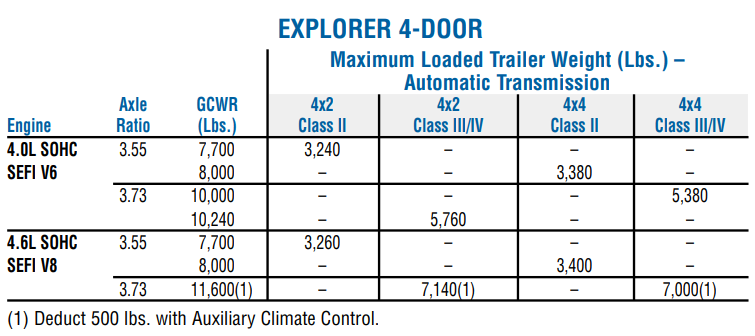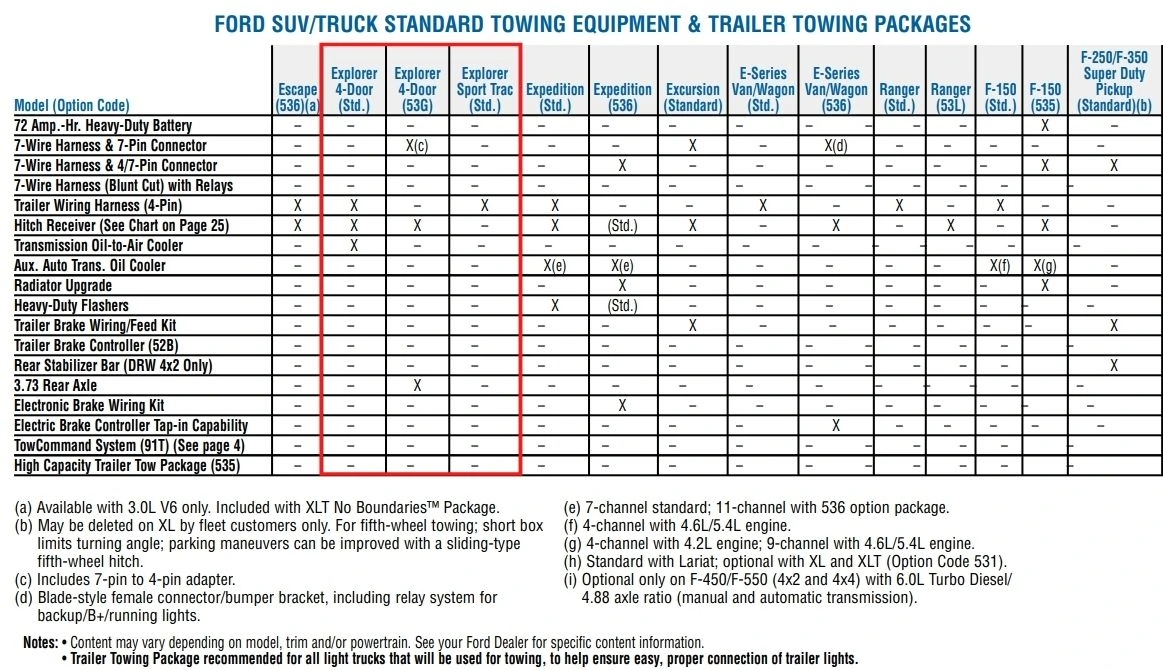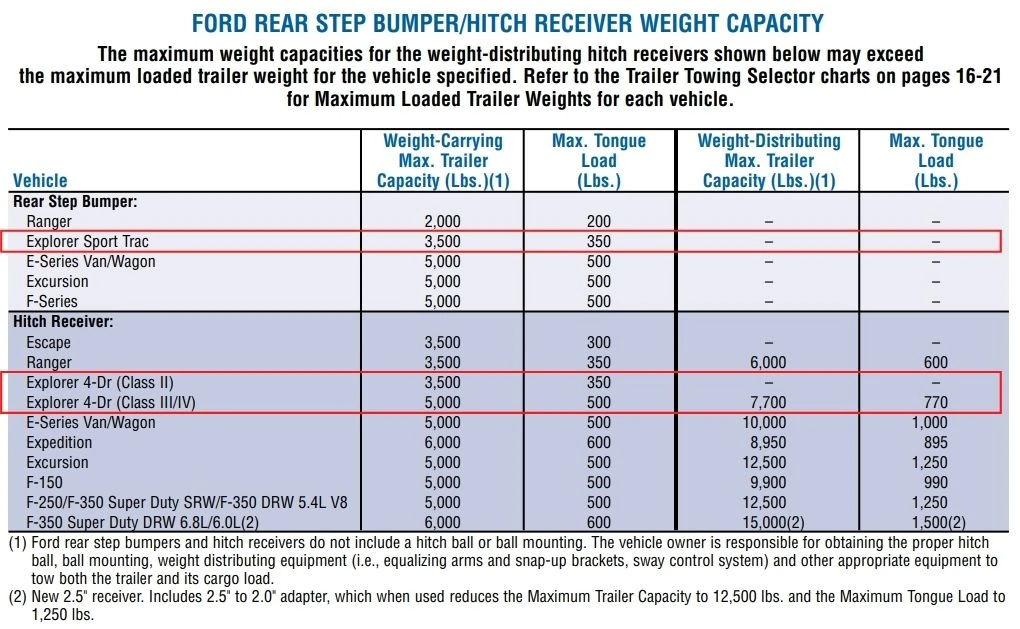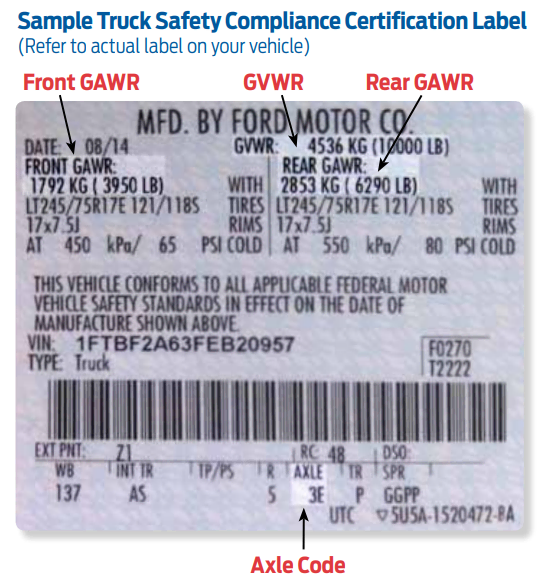- технические характеристики Ford Explorer sport trac 2000 — 2005 Пикап
- Характеристики двигателя
- Привод и трансмиссия
- Тормозная система и усилитель руля
- Размер шин
- Размеры
- Вес автомобиля
- Динамика
- Расход топлива
- Ford Explorer Sport Trac | Денег не жалко
- 2005 Ford Explorer & Sport Trac Towing Capacities (With Charts)
- The Explorer and Sport Trac Charts:
- Trailer Tow Packages and Hitch Capacities:
- The Certification Label.
- A Few Helpful Links:
технические характеристики Ford Explorer sport trac 2000 — 2005 Пикап
Технические характеристики Ford Explorer sport trac 2000, 2001, 2002, 2003, 2004, 2005: мощность, расход топлива на 100 км, вес (масса), дорожный просвет (клиренс), радиус разворота, тип трансмиссии и тормозов, размеров кузова и шин
Характеристики двигателя
| Модификации | Объём двигателя, см3 | Мощность, кВт (л.с.)/об | Цилиндры | Крутящий момент, Нм/(об/мин) | Тип топливной системы | Тип топлива |
|---|---|---|---|---|---|---|
| 4 | 4015 | 151(205)/5250 | V6 | 325/3000 | Непосредственный впрыск | Бензин |
Привод и трансмиссия
Тормозная система и усилитель руля
| Модификации | Тип передних тормозов | Тип задних тормозов | Усилитель руля |
|---|---|---|---|
| 4 | Вентилируемые диски | Барабанные |
Размер шин
Размеры
| Модификации | Длина, мм | Ширина, мм | Высота, мм | Колея передняя/задняя, мм | Колесная база, мм | Дорожный просвет (клиренс), мм | Объем багажника, л |
|---|---|---|---|---|---|---|---|
| 4 | 5230 | 1824 | 1781 | 1486/1486 | 3198 | 170 | — |
Вес автомобиля
Динамика
| Модификации | Максимальная скорость, км/ч | Время разгона до 100 км/ч, с | Cd (Коэффициент лобового сопротивления) |
|---|---|---|---|
| 4 | — | — | — |
Расход топлива
| Модификации | В городе, л/100 км | По трассе, л/100 км | Средний расход, л/100 км | Выброс СО2, г/км | Тип топлива |
|---|---|---|---|---|---|
| 4 | 14.7 | 11.7 | 13.2 | — | Бензин |
Ford Explorer Sport Trac | Денег не жалко
Ни один нормальный человек в России не станет сегодня владельцем подержанного американского пикапа Ford Explorer Sport Trac, потому что совсем недавно из-за новых таможенных правил его цена сравнялась с новым японским, а до этого он успел попасть в рейтинг самых ненадежных автомобилей США. Вы знаете, что Explorer Sport Trac имел 44 отказа на каждые 100 машин по данным опроса журнала Consumer Report (есть такое авторитетное штатовское издание с тиражом в четыре миллиона экземпляров)?
НЕ НАДО РАВНЯТЬ
Ерунда. Мы еще не превратились в скучный устаканенный европейский автомобильный рынок, где рулят практичность и экономия. Большая часть жителей России не воспринимают машину как средство передвижения. Одни – из-за избытка денежных средств, а другие – по причине их отсутствия. Пока такой бардак в самом разгаре, списывать со счетов дорогой американский пикап нельзя.
К тому же прямое денежное сравнение скромного Mitsubishi L200 и расфуфыренного Ford Explorer Sport Trac не достоверно. Только с виду пикап на базе Explorer служит более дорогим аналогом японских грузовичков. Вроде у всех сзади кузов и рессоры с неразрезным мостом, а спереди кабина и независимая подвеска с торсионами. На деле же «японцы» попадают на наш рынок вполне легальным белым путем и имеют тюремные по техасским меркам комплектации. Дизельный двигатель 2.5 л. Коробка механическая. Салон скромный. «Американец» приплывает через океан с четырехлитровым мотором V6, АКПП, кожано-электрическим нутром, люком и музыкальным автоматом на шесть дисков.
Какие у него сиденья! Я куплю этот Ford только затем, чтобы снять их и поставить у себя в комнате. Перина. Податливые, обширные, необыкновенно пышные. Как грудь доярки.
НЕ СУЙ В НЕГО ЛОПАТУ
Я нашел старый приемник VEF (вы наблюдаете его на фото) на полу второго ряда. Ему не меньше 35 лет. Поймал шипящую волну «Голос Америки» и поехал кататься. Вы когда-нибудь катались на пикапе? Уверен, что нет. Вы просто ездили или перевозили какую-нибудь дрянь типа шифера, потому что ни один японский «грузовик» даже не допустит мысли о катании, а такой машины, как Explorer Sport Trac, у вас нет. Жаль, что у меня его заберут уже сегодня.
А пока… еду. Нет, конечно, это не утилитарный транспорт. Наших деревенских дорог подвеска не выдерживает. Точнее, она не настроена под наш стиль езды по таким дорогам. Быстро нельзя. Но и это радует: «американец» настраивает на неторопливую комфортную прогулку, а его кузов для пива и ласт – не суйте в него дрова и лопаты.
Он раскачивается на грунте плавно, вминая корпус водителя в боковую поддержку, и тихонько поскрипывает кожей. А вот и другой скрип, более мощный. Это звучат рессоры, как раскладушка во время романтической беседы. Просто в рессорах поизносились полиуретановые втулки. Кстати, для перевозки серьезных грузов под 500 кг рессоры неплохо бы усилить еще одним листом, только обязательно оригинальным, иначе усилия пропадут зря.
УМРЕТ МЕДЛЕННО
Небольшую экскурсию по ходовой части пикапа можно продолжить. Посмотрим на шаровые опоры – наиболее часто меняемую в подвеске деталь. К сожалению, поставляется она только в сборе с рычагом. Таким же расходным материалом являются и амортизаторы. При выборе поставщика деталей правило опять же – только оригинал. Механики, обслуживающие американские внедорожники, придерживаются четкого мнения, что больше половины всех проблем и отказов случается из-за использования «серых» запчастей. Для примера: «родные» крестовины кардана служат по 200 тыс. км, а неоригинальные могут отказать и после 5000 км. Надо слушать профессионалов.
Единственная деталь, которую целесообразно менять на неоригинал, – качающий элемент бензонасоса. Сам бензонасос довольно дорог и в «родном» варианте продается только в сборе. Неоригинальный от фирмы Walbro перемелет любую дрянь, скопившуюся от Аи-92 на дне бака. Стоит копейки и довольно живуч. Справедливости ради необходимо отметить, что и «родной» тоже умирает медленно.
ОТДАЙ СИДЕНЬЯ
Покупатель Ford Explorer Sport Trac конченых амортизаторов не боится. Другое дело – электроника и электрика. Самое слабое место американского пикапа спрятано в проводах. Машинка холостого хода, моторчик раздаточной коробки и прочие механизмы, работающие от сети, скучать не дают.
Кислородные датчики в выпускной системе расположены как до, так и после катализаторов (их здесь два). В Москве есть мастера, успешно ампутирующие оба, перенастраивая программу двигателя.
А, к черту дефекты. Отдавать пикап законному владельцу не хотелось. Так и тянуло оставить себе хотя бы сиденья.
2005 Ford Explorer & Sport Trac Towing Capacities (With Charts)
The 2005 Ford Explorer and Sport Trac were basically identical vehicles, they just had different body styles, trim levels and engine options available to them, but other than that they were very similar.
Their towing capacity did differ, however, mainly due to the fact that there was an additional engine option for one of the models and they had different curb weights as well. There is a lot of information to go over in order to figure out what your maximum trailer weight rating is for your specific model and that’s exactly what we go into in this article, so let’s dive in!
You will want to consult your owner’s manual when it comes to anything regarding your vehicle, as it is the best resource available. I highly recommend that you stick to all of Ford’s recommendations and requirements.
Overall Capacity: The overall towing capacity for the 2005 Ford Explorers ranged from 3,240-7,140 lbs. and the ratings were affected by two main factors: the engine you had equipped and your rear axle ratio.
For the 2005 Sport Trac models, the overall range was less significant, having a range of between 5,080-5,300 lbs. and was only dependent on whether you had a 4WD or 2WD model.
Capacity By Trim Levels: There were many different trim levels for both models, which you can see listed below and I assigned each trim level their appropriate capacity range, based on the engine options that were available for each trim level. This really helps to break down the data even further, so we can make better comparisons.
- XLS: 3,240-5,760 lbs.
- XLS Sport: 3,240-5,760 lbs.
- XLT: 3,240-7,140 lbs.
- XLT Sport: 3,240-7,140 lbs.
- Eddie Bauer: 3,240-7,140 lbs.
- Limited: 3,240-7,140 lbs.
- XLS (Sport Trac): 5,080-5,300 lbs.
- XLT (Sport Trac): 5,080-5,300 lbs.
- XLT Premium (Sport Trac): 5,080-5,300 lbs.
- Adrenalin (Sport Trac): 5,080-5,300 lbs.
The 4.0L engine was the standard option for most trim levels, and the 4.6L engine was offered as an optional upgrade for some trim levels like the XLT and XLT Sport.
S/⚫ Standard ⚪ Optional — Not Available
By Engine Options: I wanted to break down the data even further and decided to look at the maximum trailer weight ratings according to the engine that was equipped and decided to list the capacity range according to the engine options that were offered for these vehicles.
- 4.0L (V6): 3,240-5,760 lbs.
- 4.6L (V8): 3,260-7,140 lbs.
- 4.0L (Sport Trac) (V6): 5,080-5,300 lbs.
The Explorer and Sport Trac Charts:
There were two separate charts listed in the guide, which makes sense because both of these models are essentially separate models, but they are similar in a sense and it’s why I decided to group them together in this article.
If we look at the two different charts below, we can see that the engine options are listed on the left and the maximum trailer weight ratings are listed on the farthest right-hand section of the table. We can also see that the axle ratio options are listed, along with the gross combined weight rating specifications.
Trailer Tow Packages and Hitch Capacities:
I was also able to find the trailer tow packages that were offered for these vehicles and I went ahead and highlighted the columns of interest in the red box. There are standard options available for each vehicle and then there was one optional package that could be installed for the Explorers that was signified as the 53G package. This table is nice because it lays out all the equipment that was offered for these vehicles.
The image below shows the hitch weight capacities, which is very interesting because most people don’t realize that in order to achieve the higher capacities that are listed in the charts, you will have to have a weight distributing hitch installed on your vehicle.
If we look at the table, we can see that the Explorer has a maximum hitch capacity of between 3,500-5,000 pounds if you’re using a standard hitch, but you’re able to achieve that higher 7,700 lb rating if you have a weight distributing hitch installed instead.
A Note On Trailer Brakes: There was not much information regarding trailer brakes for these vehicles, but I did post a screenshot of what I found in the owner’s manual below. This little note basically states that trailer brakes can be installed if they are installed properly and adjusted properly and that these trailer brakes must meet local and federal regulations in order to be compliant.
Each state will have its own laws about trailer weight and trailer brakes and each state may differ on what amount of weight will require trailer brakes to be added to your trailer. You will want to check out your local laws to be sure you comply with everything they need.
The Certification Label.
GVWR & GAWRs: The GVWR and GAWR specs were not specified anywhere in any of the resources I used for this article and that’s because these two metrics are actually listed on the vehicle itself and not in any of the online literature.
The image above shows what is referred to as the certification label and this can be found on all vehicles because it is law to have this certification label posted on the vehicle and for the 2005 Explorers and Sport Tracs, you can find this label on the door jamb or the door itself, on the driver’s side of the vehicle.
GCWR: The gross combined weight rating was listed in the charts and ranged from 7,700-11,600 lbs. for the Explorers and for the Sport Trac models, there was only one weight rating specified and that was set at 9,600 lbs. Having these specifications listed in the chart made finding them a lot easier.
Axle Code: If we refer back to the charts, we can see that you will need to figure out what axle ratio you had equipped in your vehicle, as there were two options available for the Explorers. You can get your axle code from the certification label, but it is located at the bottom of the label, kind of towards the middle and will contain a two-digit code.
You will then have to take that code and decipher it in order to figure out what axle ratio was equipped on the rear end of your SUV. Ford usually gives us a legend that decipher these codes, but they did not do it for the 2005 model year, so you will have to use a third-party website that has these codes deciphered for you, like this website.
Alternatively, you could climb under the vehicle and look at the rear axle housing and try finding a metal tag that has the stamped axle ratio in the tag.
A Few Helpful Links:
This article was unique in the sense that the Explorers and the Sport Trac models were both listed in the same article, but each of them had their own separate resources, for the most part, except for the guide that applied to all of Ford’s 2005 vehicles that had tow capabilities.
I listed each of the resources I used for this article down below for those of you out there that want a quick way to check those out for yourself. Most of the information I have in this article came directly from the guide itself, as it provided the majority of the information I needed, including a lot of the images you see in the article.
The other resources were mainly used for supplemental information and filled in the gaps when looking for specifics on certain aspects of the vehicles like the trim level options, etc.











